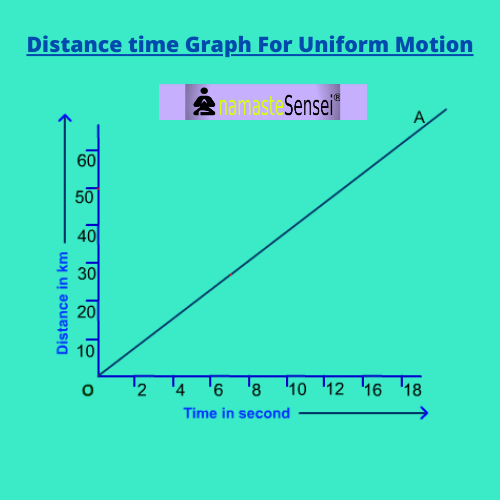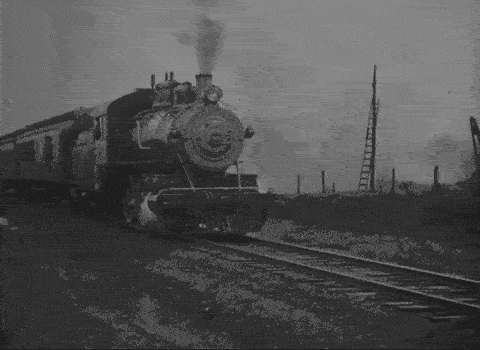-
Define Uniform Motion | What is uniform motion?

What is uniform motion?
- When a body travels in a straight line and covers equal distances in equal intervals of time, such motion is called as uniform.
- This means that the body’s velocity remains constant as it covers equal distances in equal time intervals.
- With uniform rectilinear motion, the acceleration of the body will be zero. It means speed does not change with a change in time.
Now we are familiar with the concept
Let’s understand with the help of an example.
Example
|
A car moving with a constant velocity of 12 m/s on a highway
|
|
Movement of blades of a ceiling fan.
|
-
Distance-time graph for uniform motion

- If we draw a distance-time graph for motion which will be uniform, then it will be a straight line. (As you can see above)
|
-
Examples of uniform motion
Some examples are given below.
- Rotation of Earth around its axis
- Revolution/ orbital motion of Earth around the sun
- Movements of hands of a clock
- An airplane cruising at a steady speed
- Movement of the fan
- A train going at a steady speed along the tracks
- A car moving on the highway with a fixed speed
-
ROTATION OF EARTH AROUND ITS AXIS

The very first one in my list is the rotation of the earth around its axis. If you are wondering how? then, let me tell you how.
- The rotation of the earth is Uniform as it keeps happening over a period of time at a constant speed in a continuous process.
- The Earth’s axis runs from the North Pole to the South Pole. It takes the Earth 24 hours (Actual: 23 hours, 56 minutes), or one day, to make one complete rotation around this invisible line. As the Earth rotates, each area of its surface gets a turn to face and be warmed by the sun.
-
Revolution/ orbital motion of Earth around the sun

- Earth revolves in orbit around the sun for 365 days, 6 hours, and 9 minutes with reference to the stars, at a speed ranging from 29.29 to 30.29 km/s. The 6 hours, and 9 minutes add up to about an extra day every fourth year, which is designated a leap year, with the extra day added as February 29th.
- The Earth travels in an elliptical orbit around the sun. It travels at roughly 67,000 miles per hour (or 18.5 miles a second), on this path.
- This speed of the earth’s orbital motion or to make one revolution always remains constant. As a result, the Earth travels equal distances in fixed intervals of time. It does not happen that the Earth revolves around the sun in 100 days one time and then in 365 days the next time around. Here the earth covers equal distance in equal intervals of time.
-
Movements of hands of a clock

- The distance traveled by the hands of a clock is fixed in fixed intervals of time. This means, that when an hour hand moves one unit distance, we say one hour has passed. When a second’s hand moves one unit we say 5 seconds have passed.
- Since this movement is uniform we are able to find the time. What if it moved one unit in 5 seconds and the other in 1 second, then we would be never able to guess time.
-
An airplane cruising at a steady speed

- Similar to the car on a long drive, an airplane in the sky can easily travel at a uniform speed. An aircraft at a steady speed travels at a uniform speed, which means it travels equal distances in fixed intervals of time.
- Certain factors like turbulence, turning, landing, etc may cause some deviation in speeds which is non-uniform. But, in constant speed conditions while cruising we can consider it to be an example of uniform velocity.
- When a plane takes off, it starts from zero. But when it is flying in the sky at the desired altitude and speed, this is the time when it can fly at a steady-state motion.
- Also while landing, it will again go back to its non-uniform speed.
-
Movement of the fan

- Ceiling fans as a whole “rotate” on their axis, so we can say they are doing rotational motion, whereas fan blades move in a circle with a fixed radius from the center; thus, they are doing circular motion.
- Ever seen the blades of a fan rotating when you turn on the switch, they rotate at a fixed speed. They don’t vary their speed on their own unless and until changed by controlling the regulator. Thus, the blades travel equal distances in fixed intervals, hence, this is also an example of uniformity in motion.
-
A train going at a steady speed along the tracks

- Similar to cars and airplanes, there comes a time when a train running on a track can achieve a steady-state uniform motion. At first, it will start from zero, then after achieving the desired stable speed, a train will maintain it for some time before stopping at some junction.
- The train maintains a uniform speed at some stage, that is traveling equal distances in a fixed interval of time.
-
A car moving on the highway with a fixed speed

- When you start a car, at first, the motion of a car is perfectly a non-uniform one. While driving on a highway, the road is clear of any traffic then we move ahead to speed it up and we can drive smoothly. After some time, when you have achieved your desired speed, what you wanna do is go smoothly. And especially if we put the car on cruise mode, the car will automatically cruise at the specified speed. There is no variation in speed. Such, motion is said to be in not constant or uniform.
- But, this is not the case while driving in city traffic. We are constantly stopped by traffic lights and heavy traffic at peak hours. It is almost impossible to maintain a uniform speed. Driving in city traffic is not uniform.
Recommended Read: 11 Uniform Motion Examples In Real Life
-
Frequently Asked Questions
-
does uniform motion have constant acceleration?
- No! Uniform motion is motion in which velocity is constant and acceleration is 0.
-
does uniform motion require a constant force?
- A constant supply of force is required because when a constant force is delivered to a body, the acceleration remains constant and the body continues in motion which is in uniformity.
- But, if the force is removed, the velocity diminishes and the body comes to a stop.
-
does uniform motion have to be in a straight line?
- The uniform motion of an object in which the object travels in a straight line and its velocity remains constant along that line as it covers equal distances in equal intervals of time, irrespective of the duration of the time.
-
what is uniform motion with example?
- Motion in which a body travels in a straight line and covers equal distances in equal intervals of time.
- Example – A car moving with a constant velocity of 12 m/s on a highway
-
are uniform motion and uniform speed the same?
-
The uniform motion of an object means “object covers equal distances in equal time of intervals. Object’s speed does not change and stays constant.”
-
Uniform speed means ‘speed of object stays constant or not varying. So both are the same.
-
what is the uniform motion formula?
-
The formula for such motion is d = rtd is the distancer is the ratet is the time
-
Why uniform circular motion is accelerated?
- Uniform circular motion is accelerated because the velocity changes due to continuous changes in the direction of motion. So, even when the body moves at a constant speed, its velocity is not constant. Thus, for a body moving in a circular path at a constant speed, its velocity changes.
-
is uniform motion scalar or vector?
- It is a vector quantity. Its unit is the same as speed i.e. ms-1. For uniform and linear motion, the velocity does not change over time.
Congratulations, you have read the complete article. If you have any doubts or queries, feel free to comment below. We will respond as soon as possible.
Or Email Us At [email protected]
More Articles:
| 11 Uniform motion examples in Real Life | Velocity Time graph For Uniform Motion |
| Distance time graph For Uniform Motion | Position Time Graph For Uniform Motion |
Any topic you want us to cover? Let us know.
